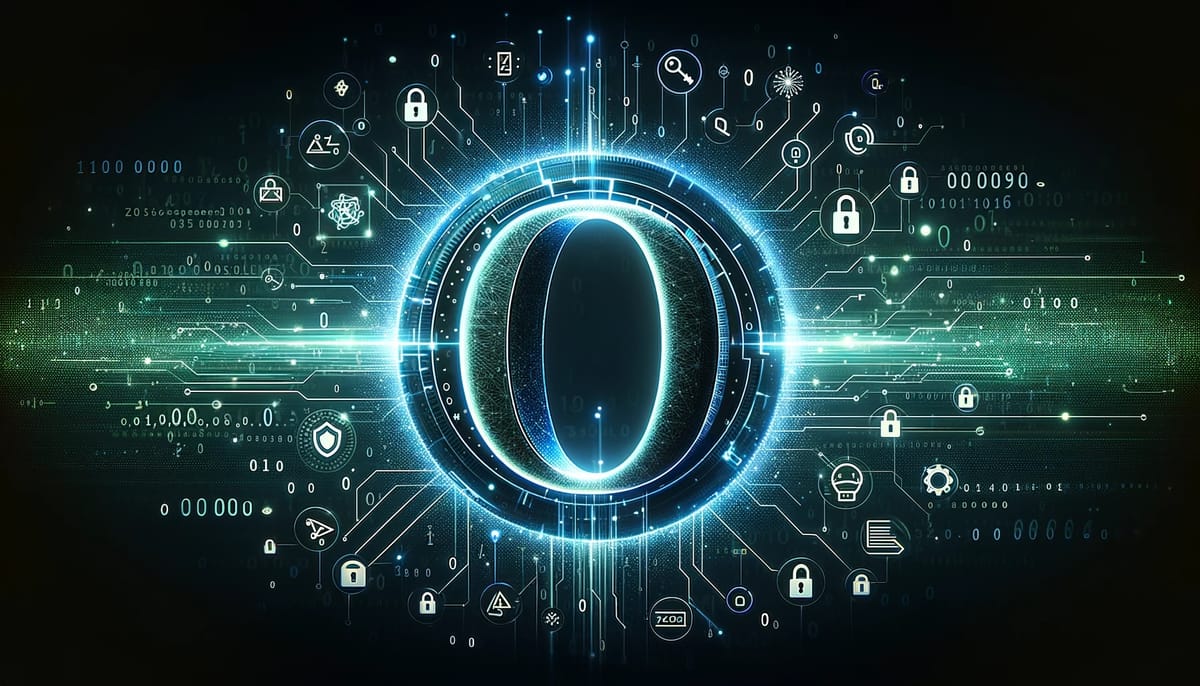Zero-Knowledge Proofs in AI
Saga is pioneering the exploration and implementation of Zero-Knowledge Proofs (ZKPs) to revolutionize the way we interact with technology and each other in the digital realm.

In the evolving landscape of artificial intelligence (AI) and humanities, the quest for innovative solutions that bolster security and trust in digital communication is paramount. Saga is pioneering the exploration and implementation of Zero-Knowledge Proofs (ZKPs) to revolutionize the way we interact with technology and each other in the digital realm. In a deep dive, featuring insights from Saga researcher Daisi S., we unravel the complexities and unveil the vast potential of ZKPs.
Understanding Zero-Knowledge Proofs: A Cryptographic Breakthrough
"A zero-knowledge proof is a way for me to cryptographically prove to you that I know some fact, without revealing to you what that fact actually is."
At its core, a zero-knowledge proof is a cryptographic mechanism that enables one party (the prover) to authenticate the truth of a statement to another (the verifier) without disclosing any additional information. This elegant solution ensures that the verifier is convinced of the fact's validity while remaining oblivious to its specifics.
In the intricate tapestry of cybersecurity and digital trust, Zero-Knowledge Proofs (ZKPs) emerge as a paradigm-shifting cryptographic protocol. This innovative concept is not merely an addition to the cryptographic toolbox; it represents a fundamental rethinking of how knowledge and trust can be shared between parties in a digital environment. At its essence, a ZKP enables one party, known as the prover, to assert the validity of a statement to another party, the verifier, without conveying any information beyond the veracity of the statement itself.
The Genesis and Evolution of Zero-Knowledge Proofs
The inception of ZKPs can be traced back to the seminal work of Shafi Goldwasser, Silvio Micali, and Charles Rackoff in the 1980s. Their groundbreaking research laid the foundational principles of this cryptographic marvel, which has since evolved and branched into various forms and applications. The beauty of ZKPs lies in their ability to maintain the sanctity of the secret while ensuring that the truth is reliably communicated, a feature that has profound implications in the realms of privacy and security.
The Mechanics of Zero-Knowledge Proofs
To demystify the operational intricacies of ZKPs, it is imperative to understand its core components:
- The Prover: The entity that possesses knowledge of a certain fact and wishes to prove its knowledge without revealing the fact itself.
- The Verifier: The entity that seeks assurance about the authenticity of the prover's claim without gaining any knowledge about the fact itself.
- The Protocol: A series of steps and interactions between the prover and the verifier, meticulously designed to ensure the proof's validity without compromising the secret's confidentiality.
The protocol typically involves a structured exchange where the prover repeatedly demonstrates their knowledge of the fact through carefully constructed challenges posed by the verifier. This iterative process ensures that the verifier gains confidence in the prover's claim without ever learning any specific details about the underlying fact.
Illustrating the Concept: The Picture of a Million Snakes

"Imagine I have a picture of a million snakes, and hidden among these snakes is a worm. I know where it is, but you don't. Through a zero-knowledge proof, I can demonstrate my knowledge of the worm's location without revealing any specifics about its whereabouts."
The Prover's Challenge: Convincing Without Revealing
This simple yet powerful example beautifully captures the essence of ZKPs - the ability to validate truth without compromising on detail or privacy. The prover, in this case, claims to know the exact whereabouts of the hidden worm. However, simply stating the location would be a straightforward disclosure, violating the zero-knowledge principle. Instead, the prover must convince the verifier of their knowledge without divulging any direct information about the worm's location. This is where the genius of ZKPs comes into play.
The Zero-Knowledge Proof: A Cryptographic Dance
To achieve this, the prover engages in a cryptographic dance, a carefully choreographed series of steps that validate their claim. They might, for instance, employ a method akin to dividing the picture into segments, ensuring the worm's location remains a secret. The verifier is then presented with a subset of these segments, enough to be convinced of the prover's knowledge but not sufficient to glean the worm's location.
In this dance, the prover might employ various cryptographic techniques, such as commitment schemes or hashing functions, to further obfuscate the worm's location while solidifying the proof of their knowledge. The verifier, through a series of challenges and responses, gains confidence in the prover's claim, all the while remaining oblivious to the actual location of the worm.
The Essence of the Analogy: The Beauty of Zero-Knowledge
This analogy beautifully highlights the core principles of ZKPs:
- Completeness: The verifier is convinced of the prover's knowledge if the claim is true.
- Soundness: The prover cannot deceive the verifier if the claim is false.
- Zero-Knowledge: The verifier learns nothing about the actual information, in this case, the worm's location, except for the fact that the claim is true.
The 'Picture of a Million Snakes' is not just an analogy; it's a narrative that simplifies the intricate nature of ZKPs. It serves as a bridge, connecting the abstract, cryptographic world of ZKPs with the tangible, visual reality that we can perceive and understand. Through such vivid illustrations, the power and potential of Zero-Knowledge Proofs come to life, demonstrating their pivotal role in enhancing privacy and security in our digital world.
The Relevance of Zero-Knowledge Proofs in Our Digital Lives
Zero-knowledge proofs are not mere theoretical constructs; they have profound implications in our everyday digital interactions. Consider the act of logging into a computer:
"Multiple times every day, we enter our passwords, exposing them to potential threats. What if we could employ a zero-knowledge proof to authenticate ourselves to the computer, confirming our identity without divulging any sensitive information? This would shield our passwords and personal data even in the event of a security breach."
Zero-Knowledge Proofs (ZKPs) stand out as a groundbreaking alternative in the domain of digital authentication, transcending traditional mechanisms like password systems and biometric checks. Their unique properties and operational paradigms offer a novel approach to establishing and maintaining digital identity and security.
Traditional Authentication Systems: Passwords and Biometrics
Traditional authentication systems, including password-based and biometric systems, are deeply ingrained in our digital lives. Password systems rely on the user providing a secret known only to them and the verifying system. However, this method has inherent vulnerabilities; passwords can be intercepted, guessed, or stolen, leading to unauthorized access. Similarly, biometric systems use unique physical characteristics (like fingerprints or facial recognition) for identification. While more secure than passwords, biometric systems also have drawbacks, such as the risk of biometric data being copied or the privacy concerns associated with storing such sensitive information.
Zero-Knowledge Proofs: A Paradigm Shift in Authentication
ZKPs introduce a paradigm shift in authentication, addressing the shortcomings of traditional systems:
- Enhanced Security: Unlike password systems, where the secret can be intercepted or stolen, ZKPs allow the prover to authenticate their identity without revealing the actual secret or sensitive information. This means that even if a verifier (or an external observer) is compromised, the user's secret remains secure.
- Privacy Preservation: In contrast to biometric systems that require the storage and processing of personal biometric data, ZKPs ensure that the user's private information is never exposed, not even to the verifier. This significantly mitigates privacy concerns and the risks associated with data breaches.
- Resilience to Attacks: ZKPs are inherently resistant to a wide array of cyber attacks. Phishing attacks, where users are tricked into revealing their passwords, are rendered ineffective, as there is no actual secret or password being transmitted. Similarly, replay attacks, where an authentication session is captured and replayed by an attacker, are futile because each ZKP session is unique and cannot be replicated.
- Interoperability and Flexibility: ZKPs can be designed to work with various types of secrets or facts, making them highly adaptable and suitable for a wide range of applications. This flexibility also allows for integration into existing systems, providing an additional layer of security without a complete overhaul of the current infrastructure.
In short, Zero-Knowledge Proofs revolutionize the way we think about and implement authentication in our digital lives. By enabling a secure, private, and attack-resistant means of proving one's identity, ZKPs offer a promising alternative to traditional password and biometric systems, paving the way for a more secure and privacy-preserving digital future.

For cryptographic engineers: a starter's guide for working with ZK proofs
Harnessing Zero-Knowledge Proofs at Saga
Saga is exploring how to leverage ZKPs to facilitate secure and private online interactions with AI. In an era marked by skepticism towards technology and interpersonal trust, the application of ZKPs is instrumental in fostering authentic human connections without risking personal data exposure.
"Our goal is to bridge the gap between humanities researchers, educators, and AI, forging a bond of trust through technology. By employing zero-knowledge proofs, we can prove our authenticity and intentions without having to reveal personal, potentially vulnerable, information [i.e., PII]."
This endeavor is particularly crucial in various scenarios where AI-driven solutions intersect with sensitive human contexts:
1. Online Education and Remote Learning
In the realm of online education and remote learning, ensuring the authenticity of students and educators is paramount. ZKPs can be employed to verify the identity of participants in online exams or collaborative projects without revealing their personal information. This ensures academic integrity and prevents fraudulent activities while maintaining privacy. It also promotes adherence to FERPA regulations in the US and similar orders worldwide.
2. Secure Communication in Research Collaborations
Researchers collaborating over digital platforms require secure communication channels that protect their intellectual property and sensitive data. ZKPs can facilitate secure and anonymous peer reviews, ensuring that feedback and knowledge are exchanged without exposing the identities or affiliations of the involved parties, thus fostering a more open and unbiased academic discourse. It can also be used to support "trustless" research data sharing or be leveraged to guarantee the absolute privacy of PII in studies with human participants.
3. Personalized Learning without Privacy Compromise
AI-driven personalized learning systems adapt to individual student needs and preferences. ZKPs can ensure that these systems tailor educational content based on authenticated learning patterns and performance metrics without accessing or revealing the students' personal data, thus upholding privacy and trust in AI-driven education. This sort of privacy protection encourages students to be forthright about their educational needs and learning gaps, as they can request remedial support without reservations.
4. Credential Verification in Academic and Professional Settings
ZKPs can revolutionize the way credentials and qualifications are verified in academic admissions, through registrar offices, and in professional job markets. Candidates can prove their qualifications, skills, or experience to institutions or employers without revealing the underlying documents or details, thus preventing identity theft and ensuring privacy.
5. Trustworthy AI in Humanities Research
In humanities research, where interpretation and context are key, AI tools need to be trustworthy and reliable. ZKPs can ensure the integrity of AI-generated data, analyses, or translations, allowing researchers to utilize AI outputs without the risk of data manipulation or bias, thus maintaining the authenticity and quality of research. As we embark on a new era of research into generative AI, it will be critical to demonstrate and validate that the products of AI have not been tampered with by third parties, so that we can "trustlessly" verify their provenance.
By integrating Zero-Knowledge Proofs into these scenarios, we at Saga strive to fortify the security and privacy of digital interactions and pioneer a future where AI and humanities coexist in a symbiotic relationship marked by trust, authenticity, and respect for human values. This visionary approach paves the way for AI solutions that are not only intelligent and efficient but also deeply aligned with the ethical and social dimensions of human life. In essence, Zero-Knowledge Proofs are more than a cryptographic novelty; they are a transformative force redefining the boundaries of privacy, security, and trust in an increasingly interconnected digital world. As we stand on the cusp of a new era in digital communication, the significance of ZKPs in safeguarding the sanctity of our digital lives while fostering a more secure and transparent digital ecosystem cannot be overstated.
Further Reading
"How to Prove a Theorem So No One Else Can Claim It" by Manuel Blum (1987)
This is one of the pioneering papers on ZKPs, presented by Manuel Blum. It introduces the concept and provides foundational insights into the mechanics of ZKPs.
"The Knowledge Complexity of Interactive Proof Systems" by Shafi Goldwasser, Silvio Micali, and Charles Rackoff (1989)
This seminal paper introduced the concepts of interactive proof systems and zero-knowledge proofs. It's a foundational text that provides a deep dive into the theoretical aspects of ZKPs.
"A Practical Guide to Zero-Knowledge Proofs" by Oded Goldreich
Goldreich's work is extensive and covers a wide range of topics in cryptography, including ZKPs. This guide offers a more practical approach and includes discussions on various implementations and use-cases of ZKPs.
"Efficient Zero-Knowledge Proofs of Knowledge Without Intractability Assumptions" by Ronald Cramer and Victor Shoup
This paper discusses efficient implementations of ZKPs, focusing on reducing computational complexity and improving practical feasibility.
"Quadratic Span Programs and Succinct NIZKs without PCPs" by Rosario Gennaro, Craig Gentry, Bryan Parno, and Mariana Raykova
This publication introduces a novel approach to constructing ZKPs and is particularly notable for its impact on the development of succinct non-interactive ZKPs, which are crucial for blockchain and other decentralized technologies.
"Zk-SNARKs: Under the Hood" by Vitalik Buterin
Although not a traditional academic publication, this blog post by Ethereum co-founder Vitalik Buterin offers a comprehensive and accessible explanation of zk-SNARKs, a specific type of ZKP that has gained prominence in the context of blockchain.

